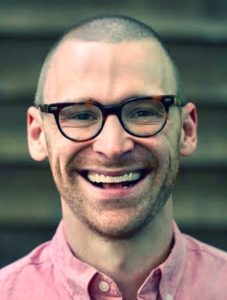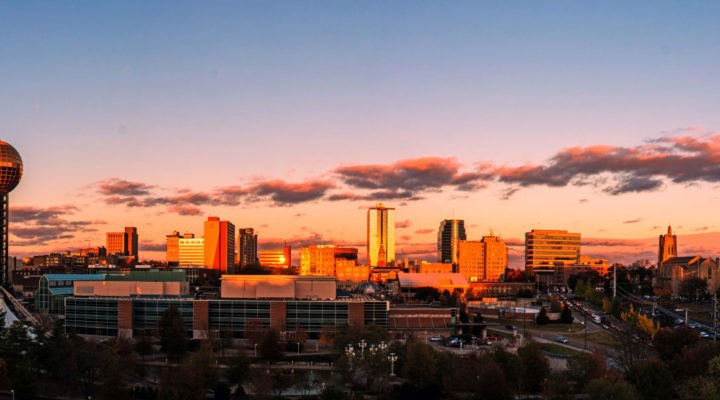I’m from Knoxville, Tenn.
You probably haven’t thought much about the mid-sized Southern city I call home for the same reasons you don’t often find yourself imaginatively drifting off in the middle of a busy work day with thoughts of your 5-year-old Honda lawnmower that always starts even if you forget to change the oil from year to year.
Our nation’s paper of record, the esteemed New York Times, once described my ancestral home as “the couch,” or “a place too unassuming to shout about but too comfortable to leave.”

Eric Minton
For much of my life I mostly believed in Knoxville’s couch-like quality. That it was and is an easy place to live, raise children and own a home. However, when I returned to it some 10 years ago as an adult, the seams on the old couch I’d called home for much of my life began to show.
This growing uneasiness with Knoxville only worsened upon my becoming a psychotherapist at my old high school, where I found that many students and families — as well as several of my former classmates and coworkers — had very different experiences with my town. With patience, kindness and a nearly inexhaustible grace, they let me in on a world where 26.5% of our residents live in poverty and where, when we account for age, this number jumps to 39% of our elementary-aged children and 34.8% of our adolescent population.
These figures only get worse if you are a Knoxvillian of color.
In 2017, our local paper, The Knoxville News Sentinel, reported that while Blacks and African Americans comprise only 17% of Knoxville’s population, 42% of them live in poverty, which far outpaces the Black poverty rates of Memphis, Chattanooga or Atlanta. Much of this 17% lives in a stretch of our community colloquially known as “East Knoxville,” which may have appeared in your Apple News Feed recently due to a spate of gun violence that has, since the beginning of 2021, tragically claimed the lives of five adolescents of color from just one high school in our city, Austin-East.
“With patience, kindness and a nearly inexhaustible grace, they let me in on a world where 26.5% of our residents live in poverty.”
Four friends from across the United States reached out to me in the wake of this week’s news cycle to ask if I was OK. Because I once worked at an “inner city school,” and because I live 3.6 miles from A-E, but I’m not really “nearby.” My relative geographic proximity is due, in some ways, to Knoxville’s size (or lack thereof), and in others to the deep-seated and long-standing community segregation that has effectively cordoned off the “inner city” and its dangers from the rest of us.

Knoxville police work the scene of a shooting at Austin-East Magnet High School Monday, April 12, 2021, in Knoxville, Tenn. (AP Photo/Wade Payne)
I’m saying I might as well live 36 miles away from what’s been happening just over the ridge. In the gap between the 3.6 miles separating Austin-East from my home exists an insurmountable trench of income inequality, payday lenders, institutional abandonment, systemic, individual and carceral racism — not to mention an almost ethereal fog that settles over most Knoxvillians like me anytime gun violence besieges “urban neighborhoods.”
When I say, “like me,” I most certainly mean well-meaning middle and upper-middle-class white people.
Cornel West once called this “fog” that thickens around us — we paralyzed, white suburban onlookers — a sort-of “deadening nihilism” that is characterized by “psychic depression, personal worthlessness and social despair,” where hope is eliminated by “a market morality that undermines a sense of meaning and larger purpose.”
“The easy narratives of race, income and social class … are but the outward manifestations of a rotted self-identity.”
In a fuller treatment on the matter, West argues that the easy narratives of race, income and social class that so thoroughly separate us from one another are but the outward manifestations of a rotted self-identity rooted in a devotion to market-mandated self-interest and scarcity as nationwide moral imperatives. To be clear, West is saying that capitalism is the thing pitting us against one another even if we use questionable racial and sociological assumptions to support our ongoing segregation.
Ibram Kendi makes a similar claim in his masterwork on the history of American chattel slavery, Stamped, as he argues for an understanding of racism as less an ideology driving violence and oppression in America, and more a sociological explanation for what is, frankly, a naked, capitalistic self-interest that predates Eugenics and Jim Crow Southern nativism.
According to both West and Kendi, no matter how thoroughly we seek to sequester the effects of our crippling addiction to self-interest within oppressed and impoverished communities bereft of resources and support, nor the lengths to which we go to blame the oppressed for their plight, nihilistic self-interest eventually takes all of us in the end. But it seems as if it’s coming for our kids first.
“Nihilistic self-interest eventually takes all of us in the end. But it seems as if it’s coming for our kids first.”
This may explain why — despite the ways in which the paths of affluent, Caucasian teenagers and those of impoverished teenagers of color in my city seem to exponentially diverge after birth — there exists a convergence of these two groups in adolescence around the loss of meaning, purpose and eventually, life itself. In some of the most affluent schools and communities in my city, ones not recently featured on your Apple News feed, there continues to be an exponential rise in teenage suicide. Nationwide, according to the CDC, suicide is the second leading cause of death in all American children aged 10 to 24, and the number of American children taking their own lives has tripled since 2007.
Whether seeing more affluent teenagers in private practice as I do now, or less affluent ones at my old high school as I once did, I am reminded of something I learned early on in my work with kids across the sociological spectrum. Namely, that even amidst sometimes inappropriate, confusing or even violent behaviors, teenagers are the “symptoms incarnate” of a much larger institutional sickness. Instead of being the problem, they reveal it, in technicolor. Or, as one of my first supervisors put it to me during a particularly trying encounter with one of these “symptoms,” teenagers are our society’s “pain made flesh.”
And if my (and your) news feed is any indication, the sickness of our self-interest is spreading no matter the amount of effort, energy and money we put into our parenting, our ZIP Codes, the professionalization of childhood, the tactical training of our teachers, or our kids’ ACT scores.
“An answer won’t likely emerge from the manic efforts of privileged people like myself.”
So in the face of yet more inexplicable violence in my city, I want to argue that an answer won’t likely emerge from the manic efforts of privileged people like myself. As we immediately cycle through knee-jerk attempts at grappling with the pain of oppressed communities. And as we immediately bypass this pain whenever it becomes complicated and demanding of us, our time, our money and our self-preservation.
In my personal experience, defensiveness and burned-out cynicism aren’t typically a recipe for transformation.
Instead, the students and faculty members I spent time with for two years in North Knoxville taught me that transformation — resurrection really — only comes for us whenever we reject the false capitalist binary of my life and your death, my success and your failure, my more and your nothing. Only when I choose to quietly bear witness and make unbroken eye contact with a pain that I have frequently ignored or even consumed as fuel for the alleviation of my own inherent white guilt, neediness and shame, can I finally encounter something that should have buried me, but doesn’t.
Owning my complicity for what happens in East Knoxville, in Minneapolis, in Cleveland, in Charleston, and in the White House as a privileged white person from “the couch,” isn’t some sort of political saber-rattle or virtue signal, it’s what my inherited evangelical tradition called an act of rededication. It’s a confession, an admittance of a sinfulness that both predates and inhabits me whenever I say things like “urban,” “impoverished,” or, you know “that” part of town.
For, as James Baldwin argues, it is only when white Americans are brought face to face with the fictions underwriting “our” history, “our” worth, “our” value, “our” neighborhoods, and “our” heritage that we might finally begin questioning the crippling capitalism that has so thoroughly blinded us to the realities of the world and has left us the “slightly mad victims of (our) own brainwashing.”
“Only the death of our crippling addiction to self-interest can save us, can free us, can resurrect us all.”
When we at long last own our brainwashing, rather than losing everything we’ve been desperately clinging to, we white Americans are finally given opportunity to return to the truth of ourselves and the world we have wrought. A truth reminding us that individual “freedom” and self-interest won’t ever save our schools, our communities, our families, our country or our souls. Only the death of our crippling addiction to self-interest can save us, can free us, can resurrect us all.
And if, during the struggle for the soul of our kids, our communities and our world, you come across a god, a political party, a faith, a politician, a social media platform, a corporation, an educational institution or a philosophy going by the name “Christian” while maintaining an unwillingness to die for the salvation of something other than itself, may you recognize it, may you face it, and may you kindly return it to its roots as a religion founded in the name of a God who dies for the world without expecting the world to return the favor.
Because as the Easter season attests, we can die alone, or we can rise, together.
Eric Minton is a writer, pastor and therapist living with his family in Knoxville, Tenn. He holds a bachelor’s degree in psychology from the University of Tennessee, a master of divinity degree from Fuller Theological Seminary and a master of science degree in clinical mental health counseling from Carson-Newman University.


